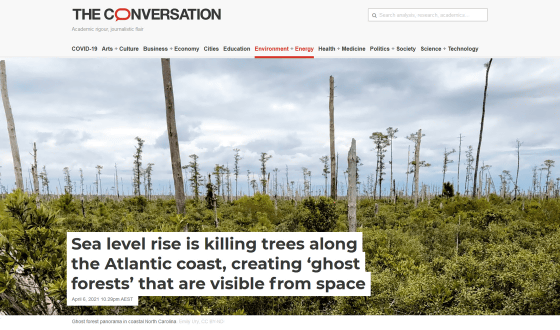A 'ghost forest' where only dead trees are lined up due to rising sea levels is born

by
Environmental changes and disasters caused by climate change have made many people refugees and have enormous impacts on nature. In recent years, trees have died due to floods caused by climate change, and ' ghost forests ' where only dead trees are lined up have been born, explains Emily Ury, a doctoral student at Duke University. doing.
Rapid deforestation of a coastal landscape driven by sea level rise and extreme events --Ury ---- Ecological Applications --Wiley Online Library
https://esajournals.onlinelibrary.wiley.com/doi/10.1002/eap.2339
Sea level rise is killing trees along the Atlantic coast, creating'ghost forests' that are visible from space
https://theconversation.com/sea-level-rise-is-killing-trees-along-the-atlantic-coast-creating-ghost-forests-that-are-visible-from-space-147971

The Alligator River National Wildlife Refuge on the coast of North Carolina, where Ury's research site is located, is said to be flooded frequently enough to submerge his knees under the influence of climate change. As a result, while the trees that had already grown died, new trees did not grow, and only the dead trees became conspicuous while standing.
In addition to the Alligator River National Wildlife Refuge, there are dead forests everywhere along the Atlantic coast of North Carolina. Ury, who examines the effects of rising sea levels on wetlands, points out that chronic floods have been caused by climate change and have changed the landscape of the Atlantic coast. Floods in coastal areas not only overflow rainwater and river water, but also cover the surface of the earth with water mixed with seawater, which increases the salinity of flooded soil.
'As with all living things, trees die, but what's happening along the coast of North Carolina is unusual. Many trees die all at once, but no alternative saplings are growing. Not only is it a problem in some areas, rising sea levels are raising salt levels in forest areas across the Atlantic coastal plains from Maine to Florida, dying vast adjacent forests. ' Ury commented. Forests where trees have died due to increased salt concentration due to floods are known by the scientific society as 'ghost forests'.

by
Rising sea levels due to climate change are flooding the plains of North Carolina with seawater and increasing the amount of salt that penetrates the soil. It is said that salt moves in the groundwater and passes through canals during droughts when freshwater is reduced, and infiltrates inland under the influence of wind and high tide.
Ury and colleagues tracked vegetation in the Alligator River National Wildlife Sanctuary for 35 years using data from NASA and the US Geological Survey's Landsat satellite, Google Earth. In this study, Ury and colleagues found that vegetation changes in more than 30% of the total forest and more than 10% become 'ghost forests,' even though the interior of the reserve is not directly affected by human development. I discovered that it has become. Forests can adapt to rising salinity and change vegetation, but if salinity rises faster than that, trees will not grow.
Looking at the pictures below, you can see that the healthy forest on the right side of the road is bright green, while the 'ghost forest' on the left side of the road has withered trees.

Vegetation changes around the Alligator River National Wildlife Sanctuary also have a chain effect on
Conservation communities around the world are taking various steps to respond to rising soil salinity as global sea levels rise. For example, the Nature Conservancy in North Carolina is trying to protect traditional forests by building a 'living coastline' of plants, sand, and rocks to protect them from storm surges.
A more fundamental approach, Ury points out, is to 'introduce highly salt-tolerant plants into areas where there is a danger of becoming a'ghost forest'.' The approach of introducing plants that are different from traditional ecosystems is controversial, but Ury argued that growing at least another plant would bring far more benefits if the forest is dying. ..

Related Posts:
in Science, Posted by log1h_ik







